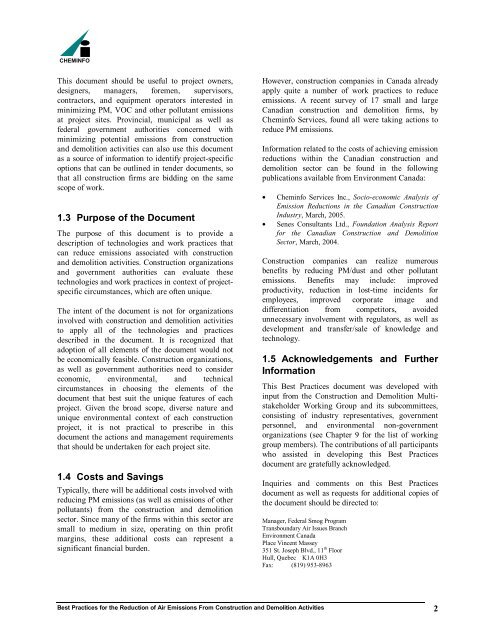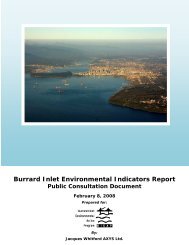Best Practices for the Reduction of Air Emissions From Construction ...
Best Practices for the Reduction of Air Emissions From Construction ...
Best Practices for the Reduction of Air Emissions From Construction ...
You also want an ePaper? Increase the reach of your titles
YUMPU automatically turns print PDFs into web optimized ePapers that Google loves.
CHEMINFO<br />
This document should be useful to project owners,<br />
designers, managers, <strong>for</strong>emen, supervisors,<br />
contractors, and equipment operators interested in<br />
minimizing PM, VOC and o<strong>the</strong>r pollutant emissions<br />
at project sites. Provincial, municipal as well as<br />
federal government authorities concerned with<br />
minimizing potential emissions from construction<br />
and demolition activities can also use this document<br />
as a source <strong>of</strong> in<strong>for</strong>mation to identify project-specific<br />
options that can be outlined in tender documents, so<br />
that all construction firms are bidding on <strong>the</strong> same<br />
scope <strong>of</strong> work.<br />
1.3 Purpose <strong>of</strong> <strong>the</strong> Document<br />
The purpose <strong>of</strong> this document is to provide a<br />
description <strong>of</strong> technologies and work practices that<br />
can reduce emissions associated with construction<br />
and demolition activities. <strong>Construction</strong> organizations<br />
and government authorities can evaluate <strong>the</strong>se<br />
technologies and work practices in context <strong>of</strong> projectspecific<br />
circumstances, which are <strong>of</strong>ten unique.<br />
The intent <strong>of</strong> <strong>the</strong> document is not <strong>for</strong> organizations<br />
involved with construction and demolition activities<br />
to apply all <strong>of</strong> <strong>the</strong> technologies and practices<br />
described in <strong>the</strong> document. It is recognized that<br />
adoption <strong>of</strong> all elements <strong>of</strong> <strong>the</strong> document would not<br />
be economically feasible. <strong>Construction</strong> organizations,<br />
as well as government authorities need to consider<br />
economic, environmental, and technical<br />
circumstances in choosing <strong>the</strong> elements <strong>of</strong> <strong>the</strong><br />
document that best suit <strong>the</strong> unique features <strong>of</strong> each<br />
project. Given <strong>the</strong> broad scope, diverse nature and<br />
unique environmental context <strong>of</strong> each construction<br />
project, it is not practical to prescribe in this<br />
document <strong>the</strong> actions and management requirements<br />
that should be undertaken <strong>for</strong> each project site.<br />
1.4 Costs and Savings<br />
Typically, <strong>the</strong>re will be additional costs involved with<br />
reducing PM emissions (as well as emissions <strong>of</strong> o<strong>the</strong>r<br />
pollutants) from <strong>the</strong> construction and demolition<br />
sector. Since many <strong>of</strong> <strong>the</strong> firms within this sector are<br />
small to medium in size, operating on thin pr<strong>of</strong>it<br />
margins, <strong>the</strong>se additional costs can represent a<br />
significant financial burden.<br />
However, construction companies in Canada already<br />
apply quite a number <strong>of</strong> work practices to reduce<br />
emissions. A recent survey <strong>of</strong> 17 small and large<br />
Canadian construction and demolition firms, by<br />
Cheminfo Services, found all were taking actions to<br />
reduce PM emissions.<br />
In<strong>for</strong>mation related to <strong>the</strong> costs <strong>of</strong> achieving emission<br />
reductions within <strong>the</strong> Canadian construction and<br />
demolition sector can be found in <strong>the</strong> following<br />
publications available from Environment Canada:<br />
• Cheminfo Services Inc., Socio-economic Analysis <strong>of</strong><br />
Emission <strong>Reduction</strong>s in <strong>the</strong> Canadian <strong>Construction</strong><br />
Industry, March, 2005.<br />
• Senes Consultants Ltd., Foundation Analysis Report<br />
<strong>for</strong> <strong>the</strong> Canadian <strong>Construction</strong> and Demolition<br />
Sector, March, 2004.<br />
<strong>Construction</strong> companies can realize numerous<br />
benefits by reducing PM/dust and o<strong>the</strong>r pollutant<br />
emissions. Benefits may include: improved<br />
productivity, reduction in lost-time incidents <strong>for</strong><br />
employees, improved corporate image and<br />
differentiation from competitors, avoided<br />
unnecessary involvement with regulators, as well as<br />
development and transfer/sale <strong>of</strong> knowledge and<br />
technology.<br />
1.5 Acknowledgements and Fur<strong>the</strong>r<br />
In<strong>for</strong>mation<br />
This <strong>Best</strong> <strong>Practices</strong> document was developed with<br />
input from <strong>the</strong> <strong>Construction</strong> and Demolition Multistakeholder<br />
Working Group and its subcommittees,<br />
consisting <strong>of</strong> industry representatives, government<br />
personnel, and environmental non-government<br />
organizations (see Chapter 9 <strong>for</strong> <strong>the</strong> list <strong>of</strong> working<br />
group members). The contributions <strong>of</strong> all participants<br />
who assisted in developing this <strong>Best</strong> <strong>Practices</strong><br />
document are gratefully acknowledged.<br />
Inquiries and comments on this <strong>Best</strong> <strong>Practices</strong><br />
document as well as requests <strong>for</strong> additional copies <strong>of</strong><br />
<strong>the</strong> document should be directed to:<br />
Manager, Federal Smog Program<br />
Transboundary <strong>Air</strong> Issues Branch<br />
Environment Canada<br />
Place Vincent Massey<br />
351 St. Joseph Blvd., 11 th Floor<br />
Hull, Quebec K1A 0H3<br />
Fax: (819) 953-8963<br />
<strong>Best</strong> <strong>Practices</strong> <strong>for</strong> <strong>the</strong> <strong>Reduction</strong> <strong>of</strong> <strong>Air</strong> <strong>Emissions</strong> <strong>From</strong> <strong>Construction</strong> and Demolition Activities 2
















